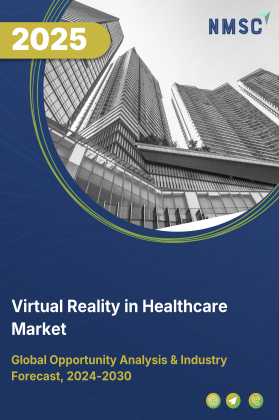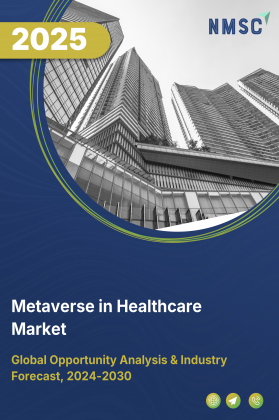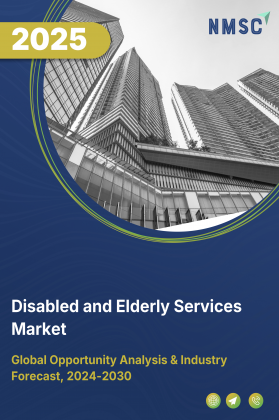
Virtual Reality in Healthcare Market by Component (Hardware, Software, Services), by Product (VR Components, VR Devices, Others), by Technology (Head-Mounted Display, Gesture-Tracking Device), by Application (Pain Management, Education & Training, Surgery, Others), by End User (Hospitals & Clinics, Research Organizations & Pharma Companies, Medical Schools & Training Institutions, Home Care & Telehealth Providers and Others) – Global Opportunity Analysis and Industry Forecast, 2025–2030.
Industry Outlook
The global Virtual Reality in Healthcare Market size is estimated at USD 7.72 billion in 2024 and is estimated to reach USD 10.44 billion in 2025 and is predicted to reach USD 47.23 billion by 2030 with a CAGR of 35.25% from 2025-2030.
The virtual reality in healthcare market is experiencing strong growth, driven by rising demand for advanced medical training, increasing prevalence of chronic diseases, and the growing use of VR in pain management and therapy. Healthcare providers are leveraging VR for immersive training, rehabilitation, and non-invasive treatments, enhancing patient outcomes while reducing risks and costs.
Despite high implementation expenses and limited accessibility in certain regions, adoption is expanding as institutions seek innovative solutions for long-term care and medical education. Moreover, the integration of VR with telehealth and remote care platforms is unlocking new opportunities, making healthcare more accessible, personalized, and efficient, thereby positioning VR as a transformative force in modern healthcare delivery.
Increasing Prevalence of Chronic Diseases Boost Virtual Reality in Healthcare Market Expansion
Increasing Prevalence of Chronic Diseases is a significant driver of virtual reality in healthcare market. Chronic illnesses such as diabetes, cardiovascular diseases, cancer and neurological disorders are rising rapidly, creating greater demand for long-term care, rehabilitation, and patient engagement solutions. According to the American Action Forum in 2025, the number of Americans living with at least one chronic disease is expected to climb to 143 million by 2050, a 99.5% increase over 30 years. This growing patient base is accelerating the adoption of VR-based therapies, including rehabilitation exercises, pain management, and cognitive therapies, as healthcare providers seek innovative approaches to improve outcomes and reduce long-term costs.
Rising Demand for Advanced Medical Training Drives the Virtual Reality in Healthcare Market Trends
Rising Demand for Advanced Medical Training is a major driver of the virtual reality (VR) in healthcare market. Traditional medical training relies on cadavers, classroom learning, or supervised practice on real patients, which be limited and risky. VR offers an immersive and interactive platform where medical students, surgeons, and other healthcare professionals simulate complex procedures in a controlled environment without endangering patients. This technology enables repeated practice, instant feedback, and exposure to rare or high-risk scenarios, ultimately improving skill development, accuracy, and confidence among practitioners.
As healthcare institutions and universities increasingly adopt VR-based training solutions to enhance education quality and reduce errors, the demand for VR in healthcare continues to grow significantly.
Growing Use in Pain Management & Therapy Fuels Virtual Reality in Healthcare Market Demand
Growing Use in Pain Management & Therapy is a strong driver of the market. VR is increasingly being adopted as a non-invasive, drug-free method to manage both acute and chronic pain. By creating immersive and interactive environments, VR distracts patients from pain signals, reducing their perception of discomfort during medical procedures, rehabilitation, or long-term treatment. It is also proving effective in therapies for conditions such as burns, cancer, musculoskeletal injuries, and post-surgical recovery. Additionally, VR is being utilized in mental health treatments for anxiety, PTSD, and phobias, where controlled virtual environments help patients gradually overcome psychological challenges.
As healthcare providers and hospitals seek alternatives to opioids and traditional pain management methods, the demand for VR-based solutions is rising, making it a crucial driver of market growth.
High Implementation Costs and Limited Accessibility Hinders the Virtual Reality in Healthcare Market Expansion
The adoption of VR in healthcare is hindered by the high cost of advanced hardware, software, and maintenance. Developing VR-based applications tailored for medical use requires significant investment, while devices such as VR headsets and haptic systems remain expensive for many hospitals, clinics, and patients.
Additionally, integrating VR into existing healthcare systems demands specialized training for medical professionals, which further increase costs and slow down adoption. Limited accessibility in low- and middle-income regions also restricts widespread use, making affordability a major restraint on virtual reality in healthcare market growth.
Integration of VR with Telehealth and Remote Care Unlocks New Growth Opportunities
The rapid growth of telemedicine is opening new opportunities for VR adoption in healthcare. By integrating VR with remote care platforms, patients receive immersive rehabilitation sessions, mental health therapy, and guided physiotherapy exercises from their homes. This not only enhances patient engagement but also reduces hospital visits, making healthcare more accessible for rural and underserved populations. With rising global investment in digital health infrastructure, the expansion of VR-enabled telehealth presents a significant growth opportunity for the market.
Market Segmentations and Scope of the Study
The market report is segmented by component, product, technology, application, end user, and region. By component, it is divided into hardware, software, and services. By product, the market is classified into VR components, VR devices, and others. By technology, it includes head-mounted displays, gesture-tracking devices, projectors & display walls, and others. By application, the market covers pain management, education & training, surgery, patient care management, rehabilitation & therapy procedures, mental health treatments, patient engagement & care management, emergency response training, and others. By end user, it is segmented into hospitals & clinics, research organizations & pharma companies, medical schools & training institutions, home care & telehealth providers, rehabilitation & therapy centers, and others. Regional analysis includes North America, Europe, Asia Pacific, and the Rest of the World.
Geographical Analysis
In North America, particularly the United States, rising investment in advanced healthcare technologies is a major driver of the virtual reality in healthcare market. According to the World Economic Forum in 2024, investments in health AI in the US alone are projected to reach USD 11 billion within the country’s USD 4.5 trillion healthcare market, supported by institutional investors and organizations. This strong funding landscape, coupled with the widespread adoption of digital health solutions and the presence of leading virtual reality in medicine technology companies, is accelerating innovation.
Hospitals and medical schools are increasingly adopting VR for surgical training, rehabilitation, and pain management, while supportive government initiatives and favourable reimbursement policies further fuel market growth across the region.
In Europe, the virtual reality in healthcare market is expanding rapidly, driven by increasing investment in digital health innovation and strong government support for advanced medical technologies. The region benefits from well-established healthcare infrastructure, active funding for research and development, and collaborative initiatives between universities, hospitals, and technology firms.
European medical institutions are adopting VR for surgical training, rehabilitation therapies, and mental health treatments, reflecting a shift toward patient-centric and technology-driven care. Additionally, the European Union’s focus on digital transformation in medical services, alongside favourable regulatory frameworks and funding programs, is accelerating the integration of VR into clinical practice, fuelling market growth across the region.
In Asia Pacific, the market is witnessing strong growth, supported by rapid digitalization, expanding healthcare infrastructure, and rising government investments in medical technology. Countries such as China, Japan, South Korea, and India are increasingly adopting VR for medical training, rehabilitation, and mental health therapy, driven by large patient populations and the rising prevalence of chronic diseases.
The region also benefits from strong innovation in consumer electronics and affordable VR hardware, making adoption more accessible compared to other markets. Additionally, government-backed digital health initiatives and public–private collaborations are accelerating the integration of VR into clinical care, positioning Asia Pacific as one of the fastest-growing markets globally.
In the Rest of the World (RoW), technological advancements in VR hardware and software are creating new opportunities for healthcare innovation. The introduction of more affordable, lightweight headsets, improved motion tracking, and portable VR solutions is making adoption feasible in regions with limited healthcare infrastructure.
Hospitals, universities, and rehabilitation centers in Latin America, the Middle East, and Africa are gradually adopting VR for medical training, therapy, and patient care. These cost-effective and user-friendly solutions help bridge gaps in access to advanced healthcare technologies, positioning VR as a valuable tool to enhance medical education and treatment outcomes across RoW markets.
Strategic Innovations Adopted by Key Players
Key players in the Virtual Reality in Healthcare industry are strengthening their market position through major strategic acquisitions and platform innovations.
-
In March 2025, XRHealth acquired RealizedCare, consolidating it into what the company calls the "world's largest AI-driven XR therapeutic platform", expanding its chronic pain and mental health offerings with AI triage tools.
-
In November 2024, XRHealth launched an AI-powered XR therapeutic platform, featuring custom 360° environments, dynamic avatars, AI-guided treatment plans, and automated session reporting to enhance personalization of care.
Key Benefits
-
The report provides quantitative analysis and estimations of the virtual reality in healthcare market from 2025 to 2030, which assists in identifying the prevailing market opportunities.
-
The study comprises a deep-dive analysis of the current and future virtual reality in healthcare market trends to depict prevalent investment pockets in the market.
-
Information related to key drivers, restraints, and opportunities and their impact on the virtual reality in healthcare market is provided in the report.
-
Competitive analysis of the key players, along with their market share is provided in the report.
-
SWOT analysis and Porters Five Forces model is elaborated in the study.
-
Value chain analysis in the market study provides a clear picture of roles of stakeholders.
Virtual Reality in Healthcare Market Key Segments
By Component
-
Hardware
-
Software
-
Services
By Product
-
VR Components
-
VR Devices
-
Others
By Technology
-
Head-Mounted Display
-
Gesture-Tracking Device
-
Projectors & Display Wall
By Application
-
Pain Management
-
Education & Training
-
Surgery
-
Patient Care Management
-
Rehabilitation & Therapy Procedures
-
Mental Health Treatments
-
Patient Engagement & Care Management
-
Emergency Response Training
-
Others
By End-user
-
Hospitals & Clinics
-
Research Organizations & Pharma Companies
-
Medical Schools & Training Institutions
-
Home Care & Telehealth Providers
-
Rehabilitation & Therapy Centers
-
Others
By Region
-
North America
-
The U.S.
-
Canada
-
Mexico
-
-
Europe
-
The UK
-
Germany
-
France
-
Italy
-
Spain
-
Denmark
-
Netherlands
-
Finland
-
Sweden
-
Norway
-
Russia
-
Rest of Europe
-
-
Asia-Pacific
-
China
-
Japan
-
India
-
South Korea
-
Australia
-
Indonesia
-
Singapore
-
Taiwan
-
Thailand
-
Rest of Asia-Pacific
-
-
RoW
-
Latin America
-
Middle East
-
Africa
-
Key Players
-
Varjo
-
Applied VR, Inc.
-
XRHealth, Inc.
-
Siemens Healthcare SAE
-
Koninklijke Philips N.V.,
-
VirtaMed AG
-
XRHealth, Inc. (XR Health)
-
Virtually Better Inc
-
Immersive Touch, Inc
-
PrecisionOS
-
SimX
-
Virti
-
AlensiaXR
Report Scope and Segmentation
|
Parameters |
Details |
|
Market Size in 2025 |
USD 10.44 Billion |
|
Revenue Forecast in 2030 |
USD 47.23 Billion |
|
Growth Rate |
CAGR of 35.25% from 2025 to 2030 |
|
Analysis Period |
2024–2030 |
|
Base Year Considered |
2024 |
|
Forecast Period |
2025–2030 |
|
Market Size Estimation |
Billion (USD) |
|
Growth Factors |
|
|
Countries Covered |
28 |
|
Companies Profiled |
10 |
|
Market Share |
Available for 10 companies |
|
Customization Scope |
Free customization (equivalent up to 80 working hours of analysts) after purchase. Addition or alteration to country, regional, and segment scope. |
|
Pricing and Purchase Options |
Avail customized purchase options to meet your exact research needs. |

















 Speak to Our Analyst
Speak to Our Analyst

























